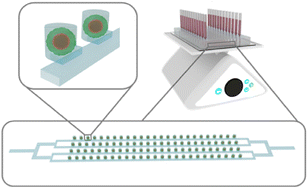Exposure of human skin to chemical agents may lead to skin sensitization, irritation, and corrosion. Time-efficient toxicity screening is currently achieved using in vitro skin-on-a-chip models; however, these either lack a multilayer structure characteristic of the skin, or require long fabrication time. Here, we report the development and proof-of-concept application of the microfluidic spheroid-based skin-on-a-chip platform utilizing gravity-driven flow and large arrays of multilayer skin spheroids (MSSs). The MSSs containing human dermal fibroblasts in the core and keratinocytes in the shell replicated the dermal and epidermal layers of skin, respectively. Within 3 days, the toxicity of five distinct small molecules was characterized by measuring their IC50 values, which enabled the differentiation of non-irritant chemical agents from the irritant ones and correlated with their in vivo scores for skin irritation. Toxicity screening was extended to nanoparticles, including carbon dots, liposomes, and insecticide-loaded liposomes. This MSS-based skin-on-a-chip microfluidic platform for the safety evaluation of small molecules and nanoparticles has diverse applications in the skincare, pharmaceutical, and agriculture fields.
